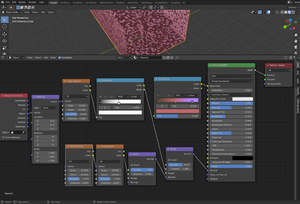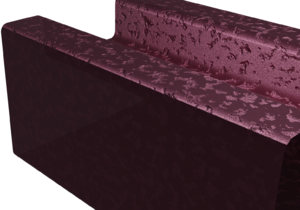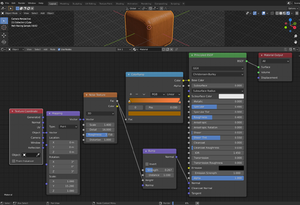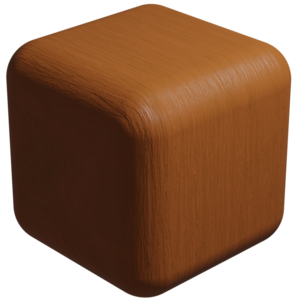Blender: Difference between revisions
| Line 97: | Line 97: | ||
* Change the origin | * Change the origin | ||
** Right click: Set Origin -> Origin to geometry. Alt+G | ** Right click: Set Origin -> Origin to geometry. Alt+G | ||
* Make a copy in Edit mode; Choose the other ( | * Make a copy in Edit mode; Choose the other (by hitting L while mouse on top), make new material and press Assign. | ||
== References == | == References == | ||
Revision as of 21:10, 25 January 2024
Introduction
Some introductory material to Blender 3D.
Theory
Add ons
- Align tool
- The animation of paths is easy with AnimAll plugin. Enable it at Preferences.
- TextFx animoitua kirjoituskonetekstiä.
Modifiers
- Array
- Bevel
- Curve
Shader Editor
Rusty metal


Add Bump (Strength: 0.5), ColorRamp (to Bump/Height), NoiseTexture (Scale: 1.5, Detail: 16), Mapping and Texture Coordinate.
Also a second Bump (to Bump/Normal), NoiceTexture (Scale: 50, Detail: 16) and NoiceTexture (Scale: 20, Detail: 16).
Wood
ColorRamp (brown, orange--brown), NoiseTexture (Roughness: 0.75, Detail: 4, Distortion: 0.7), Ctrl - T (if Node Wrangler Add On is enabled) pops Mapping (Scale X, Y or Z: 7) and Texture Coordinate (Object -> Vector).
Bump (to Principled BSDF/ Normal). NoiseTexture to Bump/ Height (Strength: 0.01).


Scientific Rendering
Molecular Visualization
Sciencevis.org
Metrics https://book.bionumbers.org/ cellPACK mMaya
- Diffusion rates
- Concentrations
- Reaction rates
- Dissociation constants
Principles and practices https://www.youtube.com/watch?v=G5FxPdBMUHE&list=PLcKSD7d0T-HBKMOGoghGk3weyrGmA2Re3&index=8
- What ideas will this molecular visualization communicate: learning objectives + what else
- Molecular structure. Structure defines functions. Structural and dynamic information should be both considered.
- Simple shape: graphical, 2d
- Arbitrary shape: misleading structural data, possible to use data if available
- Data-driven base: PDB protein Data Bank
- Atomic style: Conveys scale, complexity; shows atom types; no chains; visually complex
- Ribbon style: highlights intermediate structure, functional components, domains and linkers; however Volume is not clear
- Coarse/ tight surface style:
- What is dynamic realism; experimental data vs photorealism. MD & CG modelling.
- Crowded messines.
- Principles of molecular visualization (for your consideration)
- Molecules move by Brownian motion
- Proteins exhibit a range of flexibility
- Unproductive collisions are frequent
- Many instances of molecules and events exists
- Gravity, friction, light, color, inertia, texture are meanles.
- Use available attention cuing and communication strategies
- Depth of field, color, saturation, staging, cinematography
Blender for Scientist - Making Any molecule
Blender for Scientist - How to make protein in Blender
- Avogadro; import (or download) from PDB (eg. 1crn.pdb)
- Cartoon; use settings to
- Export to VRML
- Import X3D Extensible 3d (.x3d/wrl) and delete the extra camera.
- Tab into edit mode
- M(erge) By Distance
- Convert triangles to quads (gives better results). F3 mesh.tris_convert_to_quads -> tris to quads
- Small problems due to Avogadro: Areas of higher vertices density
- Add modifier: Subdivision surface
- Add modifier: Weld
- Apply All; or if not possible Apply both.
- Shade smooth
- Into Edit mode
- Edge -> UnSubdivide; if not smooth enough, go to Object Mode -> Add Modifier -> Subdivision
- Edge select: Choose the ring at the end of the molecule. If more ends: Shift G: Amount of Faces Around an Edge. F to fill those. [Check that the scale is one 1; Ctrl+A Scale.] Edit mode; Ctrl+B to bevel and hold shift and drag.
- Change the origin
- Right click: Set Origin -> Origin to geometry. Alt+G
- Make a copy in Edit mode; Choose the other (by hitting L while mouse on top), make new material and press Assign.
References
- https://www.youtube.com/watch?v=G5FxPdBMUHE&list=PLcKSD7d0T-HBKMOGoghGk3weyrGmA2Re3&index=8
- https://www.youtube.com/playlist?list=PLYWq6N3TyBgw472RwfniSqcGna0szGpLT